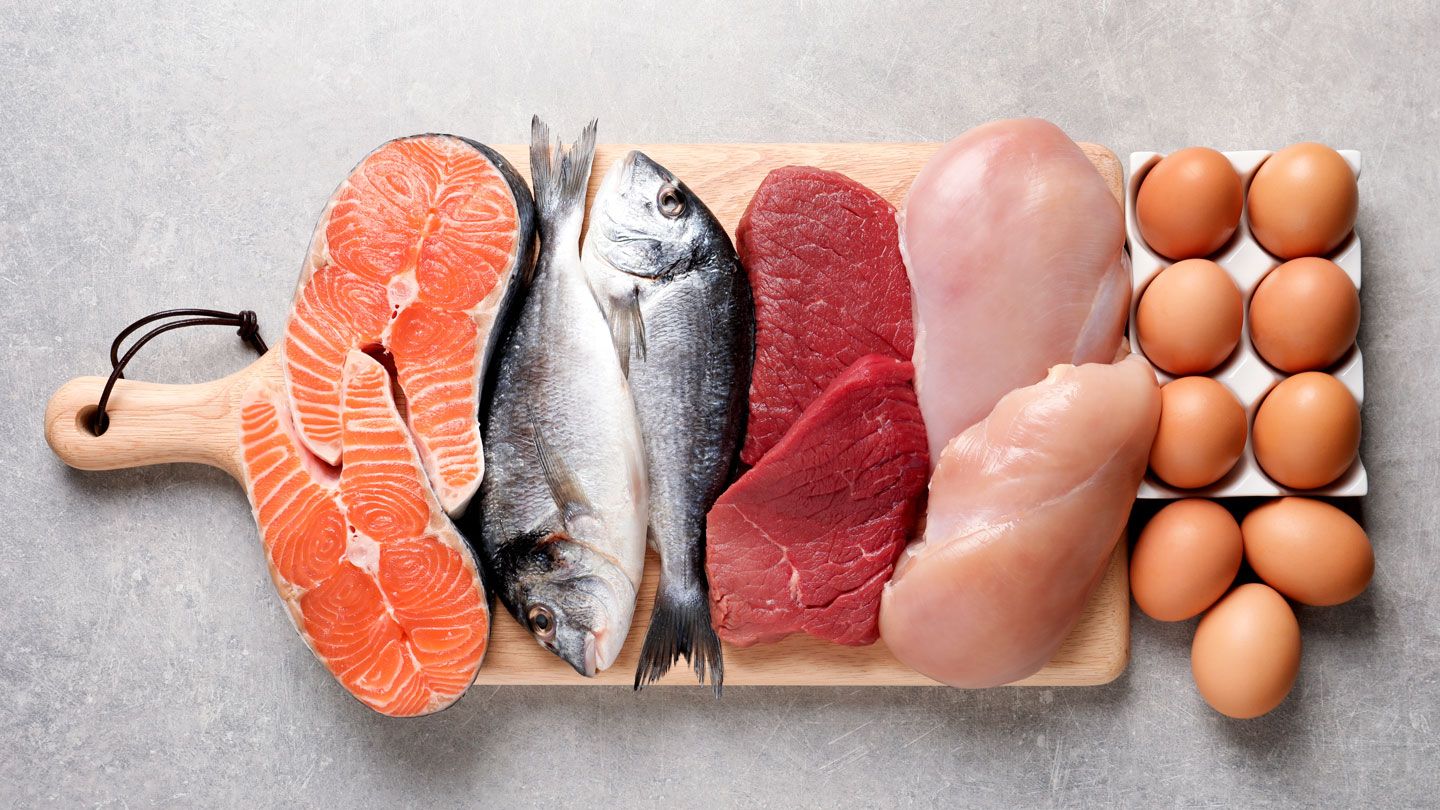High-protein foods can help you stay full and maintain and build muscle — all of which are important as you embark on a weight loss journey. But one diet suggests that it’s not just how much protein you eat, but the timing that matters, too. It’s called the Protein Pacing diet.
Keep reading to learn what the Protein Pacing diet is, whether it actually helps you lose weight, and key things that registered dietitians suggest you keep in mind if you try it.
What Is the Protein Pacing Diet?
The Protein Pacing diet was developed by Paul Arciero, PhD, a researcher in performance nutrition and exercise training and author of The Protein Pacing Diet. The lifestyle program he promotes is called PRISE, an acronym that stands for:
- Protein Pacing
- Resistance
- Interval
- Stretching
- Endurance
At its heart, this program combines a high protein diet with a well-rounded exercise plan. As for the nutrition portion, which we will focus on in this article, the following “rules” apply, according to the PRISE Life website:
- Eat four to six high-quality, protein-based meals per day.
- Space these meals evenly, eating every three hours.
- Consume 20 to 40 grams of protein at each meal.
- Eat your first meal within one hour of waking up in the morning.
- Have your last meal within two hours of going to sleep at night.
Specifically, to hit your protein target, you’re encouraged to consume 1.4 grams of protein per kilogram of body weight. To calculate your weight in kilograms, divide your weight in pounds by 2.2. For example, if you weigh 180 pounds, your weight in kilograms is 81.8. Multiple that number by 1.4 and you’ll get 114.5 — so you’ll need 115 grams of protein daily.
That’s more protein than is suggested in the Dietary Guidelines for Americans from the U.S. Department of Agriculture (USDA), which lists the current recommended dietary allowance (RDA) as 46 grams of protein per day for adult females and 56 grams of protein per day for adult males, or 0.8 grams of protein per kilogram of body weight daily.
Foods With 20-40 Grams of Protein
Curious to know what this amount of protein actually looks like? Here are some foods that hit this mark for each meal:
- 3.5 ounces of roasted chicken breast: 31 grams of protein, per the USDA.
- 1 cup low-fat (1 percent) cottage cheese: 28 grams of protein, per the USDA.
- 3-ounce turkey burger (from a 4-ounce raw patty): 22.5 grams of protein, per the USDA.
- 3.5 ounces of cooked salmon: 22 grams of protein, per the USDA.
- 3.5-ounces of cooked top sirloin steak: 29 grams of protein, per the USDA.
- 7-ounce container of plain, low-fat Greek-style yogurt: 20 grams of protein, per the USDA.
- ½ cup tofu: 21.8 grams of protein, per the USDA.
Does the Protein Pacing Diet Work for Weight Loss?
The Protein Pacing diet has been shown to be effective for weight loss and for changing body composition. Several studies (which, it should be noted, were run by Arciero and his co-authors) have looked at the impact of PRISE — which is the Protein Pacing Plus exercise program — on measures like weight loss, fat reduction, and physical performance.
In one study on people who were categorized by the researchers as obese, those who ate about six meals per day, consumed at least 30 percent of their calories from protein (about 1.4 g of protein per kg of body weight), and reduced calorie intake by 25 percent lost 10 percent of their body weight over 12 weeks, with an average loss of 23 pounds for women and 28 pounds for men. The participants also saw reductions in body fat and abdominal and visceral fat, and were able to better maintain their weight loss over the course of a year compared to people on a heart-healthy diet, according to research in Nutrients in August 2016.
One reason for that? Having a higher protein intake during weight loss helps you preserve muscle mass while you lose fat, which is important for weight management.
A small study of 41 subjects showed that combining one or two days per week of intermittent fasting with protein pacing (intermittent fasting for one or two consecutive days per week and consuming 400 to 500 calories on those days) is more effective for weight loss and a reduction of body fat, abdominal fat, and waist circumference compared to a traditional heart-healthy diet, per research in Obesity in December 2022.
Adding more protein to your diet may also offer extra weight loss benefits. “Emerging research is showing that there may be a hormonal or metabolic element to eating higher-protein meals that leads to additional weight loss,” says New York City–based Emily Field, MPH, RD. What that means is you may burn a small number of additional calories from eating foods with more protein.
However, the most critical element for weight loss is to maintain a calorie deficit through nutrition or exercise, says Field. The overarching point is that while it’s important to try to increase the amount of protein you eat per meal, calories still matter.
What Are the Pros and Cons of the Protein Pacing Diet, According to RDs?
Dietitians generally have positive things to say about the Protein Pacing eating approach. “This diet has pretty decently solid nutrition advice. It’s valid and has merit,” says Molly Kimball, RD, director of lifestyle nutrition with Ochsner Health in Harahan, Louisiana.
Here are some of the pros and cons of protein pacing.
Pro: You’ll feel fuller
A huge benefit to consuming protein throughout the day is the fullness factor. “When you eat higher-protein meals — and 20 to 40 grams is appropriate — you experience an increase in satiety and feel more satisfied,” says Field. That, in turn, may help you cut back on snacking throughout the day, another factor that can help you decrease the number of calories you consume.
Pro: You may see muscle growth benefits
Eating smaller, protein-rich meals four to six times throughout the day, as per the Protein Pacing diet recommendations, provides your body with several opportunities to improve your muscle mass. “Every time you eat, protein synthesis is triggered, which stimulates the body to build muscle,” explains Field. Breaking up protein intake throughout the day provides your body with consistent muscle-building opportunities. Think of “multiple high-protein meals like an IV drip. When it comes to protein, it’s best to drip it throughout the day to reap the benefits of muscle protein synthesis,” the expert adds.
Con: You may forget to focus on quality of other foods
Even when you’re restricting calories and focusing on eating adequate, quality protein throughout the day, don’t forget foods providing carbohydrates and fat. “Better quality foods will lead to a better energy level, alertness, and focus, as well as physical function,” says Kimball. Foods like fruits and veggies, whole grains, nuts, seeds, and beans and legumes all provide nutrients like fiber, healthy fat, and vitamins and minerals.
Con: It may be unnecessarily constraining
It’s more important to try to hit your protein target, especially if you have weight loss, body composition, or muscle building goals, than to try to force yourself to eat at a specific time before bed or even to try to eat in the morning quickly after getting up. We all have different schedules and yours might not work with that timing. For example, if you’re not hungry first thing in the morning, it’s okay to delay your first meal if you feel better doing so, Kimball says.
Another point on diet timing: Consuming protein before bed can help mitigate the natural breakdown of muscle that occurs during sleep, says Kimball. So, the advice to eat your final protein meal two hours before bed makes sense. However, she points out that there’s also been shown to be benefits to cognition, glucose control, and inflammation reduction to leave at least three hours between eating and bed. “Take your overall health and weightloss goals into consideration when determining how to adjust your meal timing in the best way for you,” Kimball says.
What to Eat and What to Avoid on the Protein Pacing Diet
Overall, this diet is flexible. According to Arciero’s website, this program can be fitted for people who are following other nutrition protocols, including paleo, ketogenic, plant-based, Mediterranean, and MIND.
What to eat
The Protein Pacing diet recommends eating animal- and plant-based protein-rich foods, powders, and bars. According to Prise Life, that can include:
- Eggs
- Poultry
- Grass-fed dairy (milk, Greek yogurt, cottage cheese)
- Wild fish
- Grass-fed beef
- Nuts
- Seeds
- Legumes
- Beans
- Pea, brown rice, or whey protein powder
- Some protein bars
What to avoid
Avoid protein foods that are highly processed, as these tend to be high in saturated fat and sodium, which aren’t healthy for your heart, according to the American Heart Association. Those foods include bacon, sausage, and hot dogs. You’re encouraged to eat whole foods, so limit those that are highly processed, such as fast food, desserts, sugar-sweetened beverages, snack mixes, and chips.
The Bottom Line
The Protein Pacing diet is a high-protein eating plan that emphasizes eating 20 to 40 grams of protein in four to six meals spread out evenly throughout the day. Research has found that this diet structure may help people lose weight, reduce body and abdominal fat, and maintain weight loss better than healthy but lower-protein plans.
If you follow this diet, make sure you are choosing high-quality proteins, such as fish, poultry, eggs, grass-fed beef, beans and legumes, and Greek yogurt, and supplementing when needed with protein powders. For tailored-to-you recommendations, a registered dietitian can help work with you to reach your specific goals.
Editorial Sources and Fact-Checking
- Paul Arciero. PaulArcerio.com
- What Is Protein Pacing? PRISE Life.
- Dietary Guidelines for Americans, 2020-2025. U.S. Department of Agriculture. December 2020.
- Chicken, Broilers or Fryers, Breast, Meat Only, Cooked, Roasted. U.S. Department of Agriculture. April 1, 2019.
- Cheese, Cottage, Lowfat, 1% Milkfat. U.S. Department of Agriculture. April 1, 2019.
- Turkey, Ground, Cooked. U.S. Department of Agriculture. April 1, 2019.
- Fish, Salmon, Atlantic, Farmed, Cooked, Dry Heat. U.S. Department of Agriculture. April 1, 2019.
- Beef, Top Sirloin, Steak, Separable Lean and Fat, Trimmed to 0” Fat, Choice, Cooked, Broiled. U.S. Department of Agriculture. April 1, 2019.
- Yogurt, Greek, Plain, Lowfat. U.S. Department of Agriculture. April 1, 2019.
- Tofu, Raw, Firm, Prepared With Calcium Sulfate. U.S. Department of Agriculture. April 1, 2019.
- Arciero PJ et al. Protein-Pacing Caloric-Restriction Enhances Body Composition Similarly in Obese Men and Women During Weight Loss and Sustains Efficacy During Long-Term Weight Maintenance. Nutrients. August 2016.
- Arciero PJ et al. Protein-Pacing and Multi-Component Exercise Training Improves Physical Performance Outcomes in Exercise-Trained Women: The PRISE 3 Study. Nutrients. June 1, 2016.
- Arciero PJ et al. Intermittent Fasting and Protein Pacing Are Superior to Caloric Restriction for Weight and Visceral Fat Loss. Obesity. December 27, 2022.
- Picking Healthy Proteins. American Heart Association. November 1, 2021.

